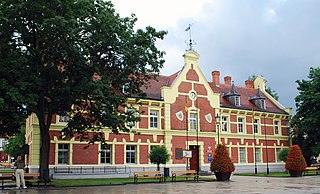
Sternberg is a town in the Ludwigslust-Parchim district of the state of Mecklenburg-Vorpommern.

The Treaty of Templin was concluded on 24/25 November 1317, ending a war between the Margraviate of Brandenburg and Denmark, the latter leading a North German alliance. During this war, Brandenburgian margrave Waldemar and his troops were decisively defeated in the 1316 Battle of Gransee, fought at Schulzendorf between Rheinsberg and Gransee. After the battle, Brandenburg was forced to negotiate a truce. The treaty of Templin was signed a year later by Danish king Erich VI Menved, his ally duke Henry II of Mecklenburg, and Waldemar.
The Treaty of Arnswalde was signed on 1 April 1269 between three Brandenburgian margraves, the Ascanians John II, Otto IV and Conrad, and Duke Mestwin II of Pomerelia in Arnswalde.

Werle was a fiefdom in the Holy Roman Empire that was founded in 1235. In German it is known as a Herrschaft or Fürstentum (principality). It was created in the partition of territories in Mecklenburg that followed the death of Henry Borwin II of Mecklenburg.

Barnim I the Good from the Griffin dynasty was a Duke of Pomerania from 1220 until his death.

Wolin Castle was a castle in the town Wolin on the island also named Wolin, owned by the dukes of Pomerania.
Wartislaw VIII was a duke of Pomerania from the House of Griffins house. He ruled in Pomerania-Wolgast from 1394 together with his brother Barnim VI. After Barnim died in 1405, he ruled alone.
Henry II, Lord of Mecklenburg, nicknamed the Lion was regent of Mecklenburg from 1287 to 1298, co-regent from 1298 to 1302 and ruled alone again from 1302 to 1329.
Swantibor III, Duke of Pomerania, or, according to a different way of counting, Swantibor I. was a member of the House of Griffins, a Duke of Pomerania-Stettin and for a while governor of the Mittelmark.
John I, Lord of Werle-Parchim, was from 1277 to 1281 to Lord of Werle and from 1281 to 1283 and to Lord of Werle-Parchim.

Henry Borwin II, Lord of Mecklenburg was a member of the House of Mecklenburg, was a Prince of Mecklenburg from 1219 to 1226 and Lord of Rostock (1225-1226).
Nicholas II, Lord of Werle was Lord of Werle-Parchim from 1283 until his death, and from 1292 Lord of Werle.
Nicholas I, Lord of Werle, was Lord of Rostock from 1229 to 1234 and Lord of Werle from 1234 until his death.
John I, Lord of Mecklenburg, nicknamed the Theologian was Lord of Mecklenburg from 1234 until his death.
Henry Borwin III, Lord of Rostock was a member of the House of Mecklenburg. He ruled the Lordship of Rostock jointly with his brothers from 1226 to 1234, then ruled alone until his death.
Rudolph I was the Roman Catholic bishop of the Diocese of Schwerin and prince of the Prince-Bishopric of Schwerin from 1249 until his death.
Nicholas, Lord of Rostock, nicknamed the child was a member of the House of Mecklenburg. He was co-ruler of Rostock from 1282 to 1284, and the sole ruler from 1284 to 1312.

The Lordship of Parchim-Richenberg was a short-lived state of the Holy Roman Empire which existed during the 13th century. It arose from the first partition of Mecklenburg after the death of Henry Borwin II, Lord of Mecklenburg in 1226. Initially it was named after its capital Parchim. Later, following the transferral of the seat to Richenberg, the name shifted to Richenberg. The Lordship comprised the lands of Parchim, the rural area of Ture and the later Vogteis of Plau, Goldberg, Sternberg and finally Richenberg. It was the shortest-lived of the four partitioned principalities of Mecklenburg.
During its history, the state of Mecklenburg has been repeatedly partitioned into various successor states. Modern historians distinguish three main Partitions of Mecklenburg:













